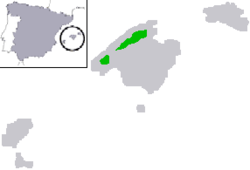Majorcan midwife toad
 From Wikipedia - Reading time: 7 min
From Wikipedia - Reading time: 7 min
| Majorcan midwife toad | |
|---|---|

| |
| Scientific classification | |
| Kingdom: | Animalia |
| Phylum: | Chordata |
| Class: | Amphibia |
| Order: | Anura |
| Family: | Alytidae |
| Genus: | Alytes |
| Species: | A. muletensis
|
| Binomial name | |
| Alytes muletensis (Sanchiz & Adrover, 1977)
| |

| |
The Majorcan midwife toad (Alytes muletensis) (also Mallorcan midwife toad or ferreret in Balearic Catalan and Spanish) is a frog in the family Alytidae (formerly Discoglossidae). It is endemic to the Balearic Island of Majorca in the Mediterranean Sea. An example of Lazarus taxon, the species was first described from fossil remains in 1977, but living animals were discovered in 1979.
The species, considered "endangered" by the International Union for Conservation of Nature (IUCN), is currently restricted to isolated mountain streams in the island's Serra de Tramuntana and has an estimated population of 500 to 1500 breeding pairs in the wild.[1] It does exist and reproduce easily in captivity, however.[citation needed] The Majorcan midwife toad is thought to have disappeared from most of the island as a result of the introduction of competitors and predators from the mainland in ancient times.[who?] Reintroduction of the species in additional areas has taken place since 1988, with many new breeding populations now well established.[citation needed]
Characteristics
[edit]Like all midwife toads, the male of the species always carries the developing eggs during the months of May and June. Generally the head and legs are large in comparison to the rest of the body. Unusually, the female of the species competes for the male, even grappling against other individuals in order to secure a mate. Both male and female frogs use a series of noises in order to attract a mate during courtship. Comparatively the female is larger than the male (Male: 34.7 mm, Female: 38 mm).
Distribution
[edit]The species is endemic to Majorca, and is found only in the mountainous regions and gorges of the Serra de Tramuntana. In this area, the species inhabits streams in limestone caverns, where they hide under boulders and stones.
Status
[edit]The Majorcan midwife toad was first discovered in 1977 and was described as Baleaphryne muletensis. Only later the toad was accounted as a midwife toad. This was due to the fact that the species was thought extinct and was described from the fossil record. Later the species was 'rediscovered' in 1979 when froglets and young frogs were discovered. Currently the species is protected as a Majorcan endemic species, and breeding programs have been started to prevent the extinction of this species. The number of wild animals is estimated at around 300 to 700 breeding pairs. It was previously housed and bred at the Durrell Wildlife Park, with the goal of releasing into the wild, which was successful.[2]
Threats
[edit]This section relies largely or entirely on a single source. (April 2024) |
Alytes muletensis faces several significant threats to its survival, primarily attributed to human-induced factors and the introduction of non-native species.[1]
Invasive species and predation
[edit]The introduction of the viperine snake (Natrix maura) poses a severe threat to the Alytes muletensis population. Predation by this non-native snake has led to a substantial decline in larval populations, with some sites experiencing a staggering 90% reduction. Additionally, competition for territory with the introduced Perez's frog (Rana perezi) exacerbates the challenges faced by the Mallorcan midwife toad.[1]
Human activities and habitat alteration
[edit]The rapid development of tourism and human settlements in Mallorca has contributed to habitat degradation for Alytes muletensis. The increased demand for water resources, including damming and canalization of streams, poses a direct threat to the species. Moreover, high human pressure on karstic creeks for recreational purposes creates the potential for the spread of disease agents, endangering the Mallorcan midwife toad.[1]
Disease introduction and lack of habitat maintenance
[edit]Chytridiomycosis, a disease introduced through captive-bred individuals of Alytes muletensis, remains a major threat to the species. Although the prevalence of Batrachochytrium dendrobatidis (Bd) reportedly declined between the 2008 and 2020 IUCN assessments, captive-bred individuals are still being released, posing the risk of introducing new diseases to wild subpopulations. Newly created breeding habitats reportedly suffer from poor maintenance.[1]
References
[edit]- ^ a b c d e f IUCN SSC Amphibian Specialist Group (2020). "Alytes muletensis". IUCN Red List of Threatened Species. 2020: e.T977A89697685. doi:10.2305/IUCN.UK.2020-3.RLTS.T977A89697685.en. Retrieved 19 April 2024.
- ^ Durrell.org. "Durrell Wildlife hosts international planning meeting for Mallorcan midwife toad | Durrell Wildlife Conservation Trust". www.durrell.org. Retrieved 2016-08-21.
External links
[edit]- Amphibia Web http://amphibiaweb.org/cgi-bin/amphib_query?query_src=aw_maps_geo-euro&where-genus=Alytes&where-species=muletensis&rel-genus=equals&rel-species=equals (Accessed August 21, 2012)
- Encyclopedia of Life http://eol.org/pages/1039071/details (Accessed August 21, 2012)
- Arkive https://web.archive.org/web/20120825083227/http://www.arkive.org/mallorcan-midwife-toad/alytes-muletensis/ (Accessed August 21, 2012)
 KSF
KSF